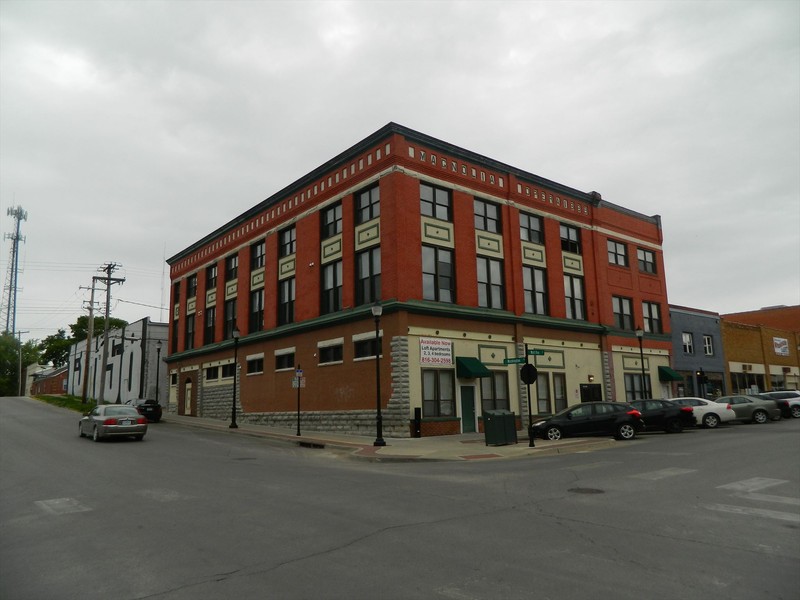Magnolia Opera House (Opera House Lofts)
Introduction
Text-to-speech Audio
The Magnolia Opera House opened in 1890 across the street from the Magnolia Mill which was founded by William Hartman and Isaac Markward in 1879. Milling proved to be a significant industry that helped Warrensburg grow during the late nineteenth century and the Magnolia Mill gained success marketing their products to locations outside Warrensburg thanks to their location next to the Missouri Pacific Railway. The partners built the theatre as part of their entrepreneurial pursuits that included retail, banking, and insurance businesses.
Images
Magnolia Opera House (Modern: Opera House Lofts)

Backstory and Context
Text-to-speech Audio
The Magnolia Opera House opened in 1890 across the street from the successful Magnolia Mill. Located near the Missouri Pacific Railway, the Magnolia Mill and other mills significantly impacted Warrensburg's growth during the late nineteenth century. Construction on the original mill took place between 1878 and 1879. The success of that mill allowed its owners to open the Magnolia Opera House eleven years later.
Warrensburg, founded in 1836 and incorporated in 1855, is the seat of Johnson County and stood as the county's largest town for much of its early history. Most of its initial success resulted from trade, inspiring investors to bring the railroad to Warrensburg by the 1850s (with the depot opening after the Civil War). The railway location spurred a shift of Warrensburg's social and business center eastward from the Main Street corridor to the Holden Street corridor; the Magnolia Opera House and Mill building sit one block west of Holden.
A significant portion of Warrensburg's growth after the Civil War resulted from a flourishing mill industry. Eureka Mills existed as one of the town's largest mills during the 1870s, which inspired others to invest in milling. William Hartman, born in New Jersey, and Isaac Markward, born in Pennsylvania, moved to Warrensburg after the Civil War (roughly 1868). They took jobs at the Eureka Mill and then, in 1878, partnered in founding Magnolia Mills. The three-story Magnolia Mills started operating in 1879 on the southwest corner of West Pine Street and Washington Avenue (it expanded to four floors in 1918). The mill occupied most of a city block. Despite competition from Eureka and the other mills, Magnolia Mills thrived, mainly because they took advantage of the railroad and shipped much of their flour to markets outside Warrensburg. Indeed, they purposely built their mill near the Missouri Pacific Railroad depot; the tracks of the Missouri Pacific Railroad ran close to the south wall of the building.
Markward and Hartman expanded upon their mill's success by constructing a combination office building and theatre -- the Magnolia Opera House, which opened on October 25, 1890. The three-story building sits at the northeast corner of Washington and West Pine. The partners proved instrumental in bringing electricity to Warrensburg. In 1893, the Magnolia Light, Heat, and Power Company was incorporated, and its power plant sat a mere one block east of the mill. As such, it is no surprise that the Opera House was one of the first buildings to be electrified. The theatre seated roughly 800 people, with 300 balcony seats and room for 500 within its main seating area. Although successful, the theatre business declined steadily by the early twentieth century, notably because of the dawn of motion pictures. The first Nickelodeon emerged in 1907 and, within a year, three more "Electric Theatres" opened. Nevertheless, the theatre hosted community theater and traveling troupes for decades.
In addition to the Opera House hosting theatre productions, the structure consisted of spaces used for offices and retailing. In fact, the ground floor included a shop the partners managed that sold Studebaker wagons and buggies, along with gasoline engines and farming implements. The store speaks to the role of the Opera House, which simply extended the partner's entrepreneurial pursuits beyond the mill. The two were also involved (separately or together) in such ventures as insurance, banking, and the Board of Trade.
Tragedy struck in 1898 when a man shot and killed Hartman, having suspected something between Hartman and the shooter's wife. Afterward, Hartman's widowed wife endured a two-year legal battle regarding her husband's share of the business. Finally, in 1900, Markward bought Hartman's wife and children's interest in the company at a partition sale. Markward ran the mill for only three more years before selling it to an investment company in 1903. Today, a part of the mill stands, as does the Opera House, which now goes by Warrensburg Opera House Loft Apartments.
Sources
"April 1879 Magnolia Mills and in 1890 Magnolia Opera House Opens at Pine-Washington Intersection." Show Me the History: Johnson County & West Central, Missouri (blog). June 22, 2017. https://1973whsreunion.blogspot.com/2014/01/april-1879-magnolia-mills-and-in-1890.html.
Nugent, Rachel and Alison Dunleavy. "Nomination Form: Holden and Pine Streets Commercial Historic District." National Register of Historic Places. mostateparks.com. 2017. https://mostateparks.com/sites/mostateparks/files/Holden%20and%20Pine%20Sts%20Com%20HD.pdf.
Sheals, Debbie. "Nomination Form: Magnolia Mills." National Register of Historic Places. mostateparks.com. 1996. https://mostateparks.com/sites/mostateparks/files/Magnolia%20Mills.pdf.
https://www.waymarking.com/waymarks/WMW2J6_1889_Magnolia_Opera_House_Warrensburg_Mo
